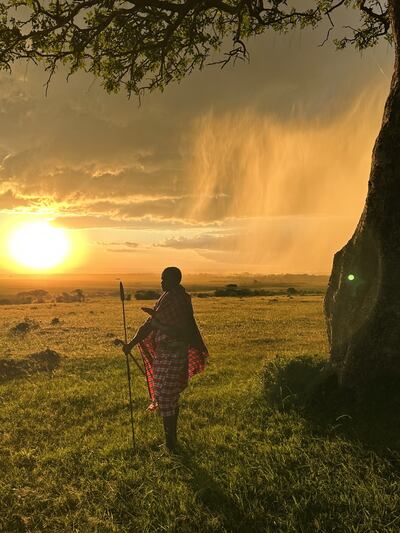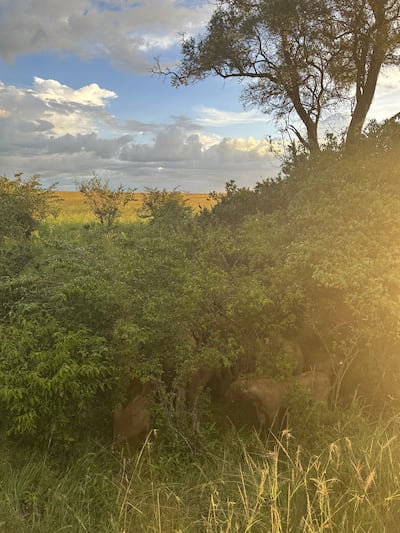Heading to the JW Marriott Masai Mara Lodge in Kenya, our adventure begins the moment we step off our 13-seater Cessna plane.
We set foot on Keekorok Airport's unpaved airstrip, the vast plains of the Masai Mara, one of the most important reserves in the world, spread out far and wide. Green hills roll in the distance, some of the view obstructed by tall grass.
Aside from the rudimentary rooms that serve as offices for the airport, it only takes a moment to realise we were already in the middle of the wilderness. This is a place renowned for its lion, leopard, cheetah and elephant populations.
We are being picked up in a customised open-sided Toyota Land Cruiser that takes us to the rugged terrain effortlessly, making the 30-minute drive to the resort a breeze. Within minutes, we spot gazelles peeking from behind the grass, some curiously scanning as we stare back and whizz past like bobbleheads.
Elephants, hyenas, giraffes and more gazelles dot the landscape as we drive along the dirt road, as it slowly begins to sink in that the Masai Mara is a place like no other.

The JW Marriott Masai Mara Lodge is the first luxury safari property operated by Marriott International, the largest hotel chain in the world. Opened in April, the resort sits within the Masai Mara and is built along the Talek River, a water source for many animals in the area.
As a result, the property is deliberately not fenced off from the rest of the reserve. This naturally makes the tantalising prospect of a close encounter with wildlife that much more real.
However, as any sensible person would know – and as the resort's staff will keep reminding you – one does not simply wander off alone, even within the property. Instead, we are to ask for an escort wherever you're headed, especially in the evening, whether it is to the pool, spa, gym, restaurants or even to and from your own suite.
The hotel employs warriors from the ethnic Masai people, after whom the reserve is named, for this purpose. Known for their fearsome reputation and unique customs, they are a comforting presence within the resort, dressed in their traditional robes and distinctive piercings, complete with their menacing weapons.
But my escort Mike, a soft-spoken man with a huge smile, is far from intimidating. On our many walks to and from my tent, we talk about life and family. He's thrilled to share stories about his young daughter whom he wants to send to school when she's older. Education changed his life, he tells me, and he wants to see more youngsters from his village, about a five-hour drive from the resort, go to school, find employment and better their lives.
The Masai people are traditionally pastoralists, and historically lived in different settlements spread across the vast Mara. But modernism and tourism have drastically changed their way of living, with many giving up their nomadic life in favour of waged employment.
Like Mike, many of them are also employed in the tourism industry.
At the JW Marriott Masai Mara Lodge, for example, 60 per cent of the team are locals as part of its mission to contribute to the region. The hotel also runs an Apprenticeship Programme, teaching young women from the Masai community various skills so they can kick-start their careers in hospitality.
This is a striking property that's made up of a collection of 20 luxury private tents or suites of similar sizes, dotted along the winding Talek.

Seamlessly blending into the savannah, a dramatic suspension bridge leads guests over the Talek and into the reception and lounge area that also functions as the heart of the lodge. This is where guests can wine and dine, or lounge around the massive fireplace built around a giant fig tree, before being escorted to their tents.
Soft and natural tones and rich textures dominate the elegant interiors, which I can only describe as safari-chic. The design theme also extends to the individual tents, built on raised wooden platforms. Inside is a generous lounge area, a four-poster bed and work desk.
Enclosed by canvas walls on three sides, one side features floor-to-ceiling windows, framed by solid wood, through which you can see the great forest beyond. This side of the wall opens to a massive terrace with its own seating area as well as an outdoor hot tub, with the Talek River flowing below. The fully-stocked bathroom's shower also leads to an outdoor shower area for that ultimate one-with-nature experience.
While well-connected with Wi-Fi, it's no wonder there are no television sets anywhere.
All tents at the JW Marriott Masai Mara are similar in size with the exception of the honeymoon suite, which comes with its own private plunge pool, as well as two interconnecting king and twin suites.

For those looking for the ultimate relaxation, the Spa by JW offers a range of signature treatments with locally inspired therapies. A fully-equipped gym is also next door.
While it's a tempting prospect to just while away your time at this luxury resort, the hotel also organises plenty of game drives, bush meals and sundowners in the wild, all included as part of the stay. Those travelling between June and September can also witness the annual great wildebeest migration, where more than 10 million animals travel a distance of 1,800 miles from the Serengeti in neighbouring Tanzania, crossing the Masai Mara on the way.
My personal favourite is the early morning game drive, which is the best time we're told to spot the Masai Mara's “Big Five” in all their glory: lions, leopards, buffaloes, rhinoceros and elephants.
Setting off at dawn, the 1,510-kilometre-square reserve is picture-perfect wherever you look. Watching the sun's soft glow light up the terrain as wild animals roam freely a few feet away is a surreal experience.

Within minutes, our driver is radioed about a pride of lions who've been spotted feasting on the carcass of a buffalo they'd just hunted. We arrive at the location along with almost a dozen other safari vehicles and see forest rangers directing "traffic", ensuring the animals are not disturbed and that each vehicle is given a chance to go as close as possible.
We drive close enough to be able to hear the growls, the tearing of flesh and the chomping of bones, and watch in rapt attention along with a pack of jealous hyenas waiting patiently for potential leftovers.
Out of the Big Five, we don't see any rhinoceros. While that's the perfect excuse to return to this magical place, it's also a stark reminder that many of our majestic creatures are becoming harder and harder to find.
















